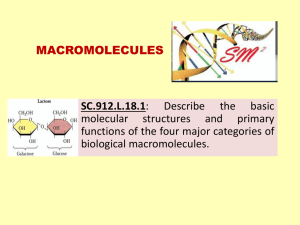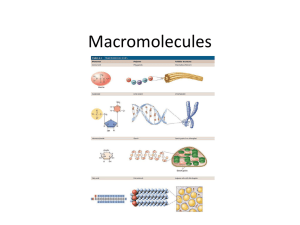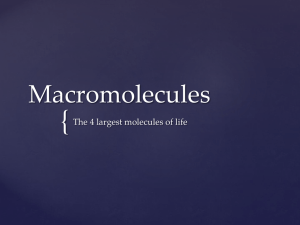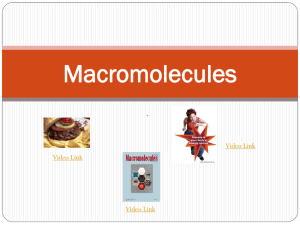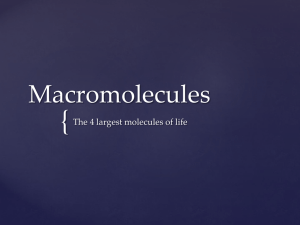Section A Cells and Macromolecules
advertisement
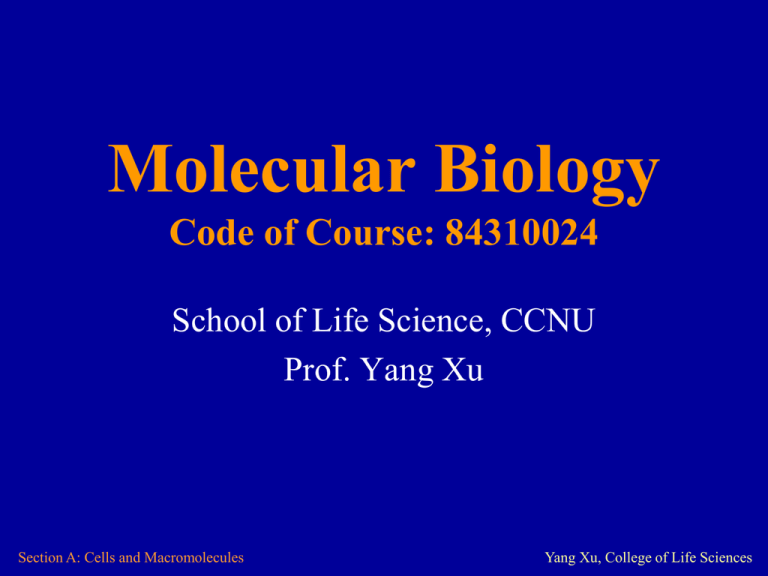
Molecular Biology Code of Course: 84310024 School of Life Science, CCNU Prof. Yang Xu Section A: Cells and Macromolecules Yang Xu, College of Life Sciences Section A Cells and Macromolecules Section A: Cells and Macromolecules Yang Xu, College of Life Sciences A1 Cellular Classification • Prokaryotes – Eubacteria – Archaea • Eukaryotes – – – – Animals Plants Fungi Protists (algae and protozoa) Section A: Cells and Macromolecules Yang Xu, College of Life Sciences Eubacteria • Structural organization – Plasma membrane – Most have a rigid cell wall – Cytoplasm contains a nucleoid – Ribosomes – Pili and flagella • Other components cell wall Plasmids /RNA /proteins and so on Section A: Cells and Macromolecules 质粒 Yang Xu, College of Life Sciences Archaea • Structurally, they are similar to eubacteria; • In energy production and metabolism they are most like those of eubacteria; • In replication, transcription and translation they are more similar to those of eukaryotes. Section A: Cells and Macromolecules Yang Xu, College of Life Sciences Eukaryotes • Subcellular compartments (organelles): – Nuclei /mitochondria Golgi complex /endoplasmic reticula ; – They bounded by lipid membranes ; – They are the sites of distinct biochemical processes and define the eukaryotes. Section A: Cells and Macromolecules Yang Xu, College of Life Sciences Eukaryotes • Cytoskeleton (protein fibers) – Microtubules, made of tubulin – Microfilaments, made of actin Section A: Cells and Macromolecules Yang Xu, College of Life Sciences A1 Fig. 2. Schematic diagram of a typical eukaryotic cell Section A: Cells and Macromolecules Yang Xu, College of Life Sciences A3 Macromolecules • • • • • Proteins (See Section B) Nucleic acids (See Section C) Polysaccharides Lipids Complex macromolecules Section A: Cells and Macromolecules Yang Xu, College of Life Sciences Polysaccharides (I) Polysaccharides are polymers of simple sugars covalently linked by glycosidic bonds. Glucose of plants: Cellulose is a linear polymer with (l4) linkages; Starch contains two components: - -amylose, a linear polymer with (l→4) linkages; - amylopectin, a branched polymer with additional (l→6) linkages. Section A: Cells and Macromolecules Yang Xu, College of Life Sciences A3 Fig.1. The structure of celluose (b) Starch (l→4)linkages (a) Cellulose (l4) linkages Section A: Cells and Macromolecules Yang Xu, College of Life Sciences Polysaccharides (II) • Glucose polymers of animals: – Glycogen is a branched polymer like amylopectin • Chitin is similar to cellulose, but the monomer is different – is found in fungal cell walls, and – is found in the exoskeleton of insects • Muco/poly/saccha/rides form the gel-like solutions, in which the fibrous proteins of connective tissue are embedded. Section A: Cells and Macromolecules Yang Xu, College of Life Sciences Lipids (I) Lipid molecules are mainly hydrocarbon • Glycerides have one, two or three long-chain fatty acids esterified to a molecule of glycerol; – In animal triglycerides are solid (fats) at room temperature; – In plant triglycerides are liquids (oils) at room temperature Section A: Cells and Macromolecules Yang Xu, College of Life Sciences Lipids (II) • Phospholipids – are important constituents of all cell membranes, – consists of glycerol esterified to two fatty acids and one phosphoric acid. – The phosphate is also usually esterified to a small molecule: serine or choline and so on. • Sphingolipids • Sphingomyelin Section A: Cells and Macromolecules Yang Xu, College of Life Sciences Complex macromolecules • Nucleo/proteins – contain both nucleic acid and protein, – for example: telomerase and ribonuclease P • Glyco/proteins and proteo/glycans – are proteins with covalently attached carbohydrate – and are generally found on extracellular surfaces • Lipid-linked proteins: covalently attached Lipo/proteins: noncovalently attached • Glycolipids – covalently linked lipid and carbohydrate Section A: Cells and Macromolecules Yang Xu, College of Life Sciences A3 Fig.3. Glycoprtein structure Section A: Cells and Macromolecules Yang Xu, College of Life Sciences A4 Large Macromolecular Assemblies • Protein complexes • Nucleoprotein • Membrances Section A: Cells and Macromolecules Yang Xu, College of Life Sciences Protein complexes • The eukaryotic cytoskeleton consists of various protein complexes: – microtubules (made of tubulin) – Microfilaments (made of actin and myosin) – intermediate filaments (containing various proteins). • These organize the shape and movement of cells and subcellular organelles. • Cilia and flagella are also composed of – microtubules complexed with dynein and nexin. Section A: Cells and Macromolecules Yang Xu, College of Life Sciences Nucleoprotein • Ribosomes – Bacterial 70S ribosomes have • a 50S subunit, with 23S and 5S RNA molecules and 31 proteins, • a 30S subunit, with a 16S RNA molecule and 21 proteins. – Eukaryotic 80S ribosomes have • a 60S (28S, 5.8S and 5S RNAs) subunit, and • a 40S (18S RNA) subunits. • Chromatin contains DNA and basic histone proteins. • Viruses are also nucleoprotein complexes. Section A: Cells and Macromolecules Yang Xu, College of Life Sciences Membranes • Lipid bilayers – Membrane phospholipids and sphingolipids form bilayers – the polar groups on the exterior surfaces and – the hydrocarbon chains in the interior. • Membrane proteins – may be peripheral or integral and – act as receptors, enzymes, transporters or mediators of cellular interactions. Section A: Cells and Macromolecules Yang Xu, College of Life Sciences A4 Fig. 2. Schematic diagram of a plasma membrance Section A: Cells and Macromolecules Yang Xu, College of Life Sciences Membrane protein functions • Receptors for signaling molecules such as hormones and neurotransmitters; • Enzymes for degrading extracellular molecules before uptake (吸收); • Channels for the selective transport of small, polar ions and molecules; • Mediators of cell-cell interactions (mainly glycoproteins). Section A: Cells and Macromolecules Yang Xu, College of Life Sciences That’s all for Section A Section A: Cells and Macromolecules Yang Xu, College of Life Sciences
